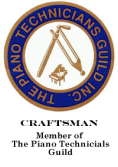Frequently Asked Questions
How often should my piano be tuned?
Most piano manufacturers recommend twice a year. In reality your tuning schedule depends on a variety of factors, including the frequency of use, fluctuations of temperature/humidity inside your house, the build of the piano itself, and your family’s ability to tolerate out-of-tune pianos. While some concert grand pianos are tuned multiple times a week, some people can get away with tuning once a year. I personally recommend tuning your piano at least once per year.
What is a “pitch raise” and why is it sometimes necessary?
A pitch raise means the piano is so flat it has to be tuned twice. Raising the pitch on a piano requires increasing the tension of the strings. Increasing the string tension causes the piano soundboard and frame to compress slightly, which in turn, lowers the tension on the strings. When I tune a piano that is a half step (100 cents) flat, by the time I finish tuning, the notes in the middle drop about 20-30 cents from where I originally tuned them. When I do a pitch raise, I start by doing a “rough tune” where I tune all the notes slightly sharp. I then start over with a “fine tune” putting each note exactly in tune.
How long will a piano tuning take?
An average tuning takes about 1.5 hours, which includes the extra work, repairs, or regulation that comes with the tuning. That said, I try to plan on about 2 hours in case a pitch raise or major repairs are needed.
What causes pianos to go out of tune?
Seasonal changes are the biggest reason for pianos going out of tune, with humidity and temperature being the main culprits. Increasing humidity generally causes pianos to go sharp (unevenly) while decreasing humidity causes them to go flat. Extreme and frequent temperature swings can also cause pianos to go out of tune (which is why tuners recommend that you don’t place your piano under a window or over a heating vent). In addition to this, pianos (particularly newer ones) tend to go flat over time as the strings stretch and parts compress. Hard playing can also cause pianos to go out of tune, though this can be partially mitigated by a good piano tuner.
Do I need to send my children out of the house during an appointment?
No. Some piano tuners like to work in a very quiet environment, and I respect that, but there is no need to send your kids out. As long as they aren’t banging pots and pans, using the vacuum cleaner, or practicing the violin, I’ll be just fine. Besides, children like to see what’s inside the piano, and they just might think it’s so cool that it will help motivate them to keep practicing.
I’d like to rent a piano. Do you know of any resources?
There are many piano stores in the area that provide this service, for instance, The Steinway Gallery has a variety of pianos for rent.
How do I get rid of an old piano?
Old pianos are kind of a tricky business. Depending on the condition of your piano, your first stop could be Craigslist. If you are in a hurry, however, or have a piano that is so broken down that won’t even go for free, I recommend contacting a local piano mover who can move your piano for a reasonable fee and then either try to salvage it or use it for parts.
|
Services
Tuning: A full tuning includes putting your piano at standard pitch (A=440Hz) and insuring stability in each and every string and tuning pin. Pitch raise: Some pianos are so flat that they require two consecutive tunings: a quick "rough" tune followed by a thorough "fine" tune. Regulation: Making sure the parts of the piano work together properly. This will improve the feel of the piano, increase control and response, and eliminate problems like double-hitting hammers, non-working dampers, sticking keys, etc. Repairs: This can involve fixing or replacing anything that is broken or missing, including key ivories, pedals, screws, hammers, strings, keys, action parts, hinges, knobs, etc. Refurbishment: Includes replacing old worn felt, replacing hammers and action parts, replacing hammers or dampers, installing new keytops, restringing, pin block, soundboard, etc. Voicing: Modifying a piano's hammers to achieve a better tone (often via softening the felt or reshaping the hammers). Player Systems: Installation and repair of the following systems: QRS Pianomation, Pianodisc, and Disklavier Damp Chaser Installation: Certified installer |

